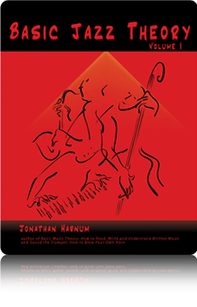About Basic Jazz Theory: Part 1
 Click the cover to buy a copy.
Click the cover to buy a copy.
Jazz is best learned by listening and imitation, not theory. Still, the theory behind the music will help you understand both why jazz sounds the way it does, and how to play jazz in a way that sounds great. Theory will also help you communicate with other musicians.
Jazz musicians share a musical language of tunes, chord progressions, licks, and stories. If you “speak jazz,” you can walk into a jam session anywhere in the world and communicate through music even if you don’t speak the local language.
Basic Jazz Theory, vol. 1 will get you started on the basics of jazz theory and will help you build the skills you need to be an excellent jazz player.
Book Details:
Jazz musicians share a musical language of tunes, chord progressions, licks, and stories. If you “speak jazz,” you can walk into a jam session anywhere in the world and communicate through music even if you don’t speak the local language.
Basic Jazz Theory, vol. 1 will get you started on the basics of jazz theory and will help you build the skills you need to be an excellent jazz player.
Book Details:
What’s Inside and the Printable Extras:
Every chapter includes:
Paperback now available in Europe
UK: Clearly written and easy to understand.
France: Écriture claire et simple. Un bon livre pour pratiquer l'anglais.
Deutschland: Klare und einfache Schreiben. Ein gutes Buch, um Englisch zu üben.
Italia: Scrittura chiara e semplice. Un buon libro per praticare l'inglese.
España: Una escritura clara y sencilla. Un buen libro para practicar Inglés.
E-book available worldwide
- Chapter 0: The Chapter Everyone Skips: Information about the book, skills you need, and how to use it.
- Tunes: melodies are the basis of a jazz player’s vocabulary. Learn about jazz standards and how to play them. Free sheet music included for the standard Dark Eyes for rhythm section and 'bones (in the book) and the printable PDFs below for other instruments:
- Scales: major scales, modes, pentatonics and the blues scales are covered in detail, each with their own chapter and related practice material.
- Intervals: intervals help you understand chords and notation more clearly. Learn the specifics inside.
- Chords: the basic building blocks of jazz harmony. All you need to know about basic chords is here.
- Extensions: jazz players add extra notes to chords to give them more flavor. Learn what they are and how to read them, and how to make some yourself.
- Listening: this is one of the most crucial aspects of learning to play jazz. Find some of the best recordings and players to listen to inside this book. Recordings in this volume have been chosen for their listenability, quality, and ease of playing for yourself, the melodies anyway. Some very simple tunes have fantastic improvisations attached to them when played by an artist.
- Ear Training: playing jazz means you have to listen and understand what you hear. This takes work. Every chapter has ear training exercises.
- Improvising: jazz without improvising would be like a birthday cake without frosting or candles. Find suggestions to improve your improv.
- Bonus Chapter (.5): Scales: A brief chapter on scales, how to practice them, and many patterns to apply to them. All major, natural minor, and blues scales are written out.
Every chapter includes:
- Review questions to test your knowledge.
- Ear training exercises to get concepts in your ears.
- Practical use exercises so you use what you’re learning.
Paperback now available in Europe
UK: Clearly written and easy to understand.
France: Écriture claire et simple. Un bon livre pour pratiquer l'anglais.
Deutschland: Klare und einfache Schreiben. Ein gutes Buch, um Englisch zu üben.
Italia: Scrittura chiara e semplice. Un buon libro per praticare l'inglese.
España: Una escritura clara y sencilla. Un buen libro para practicar Inglés.
E-book available worldwide

